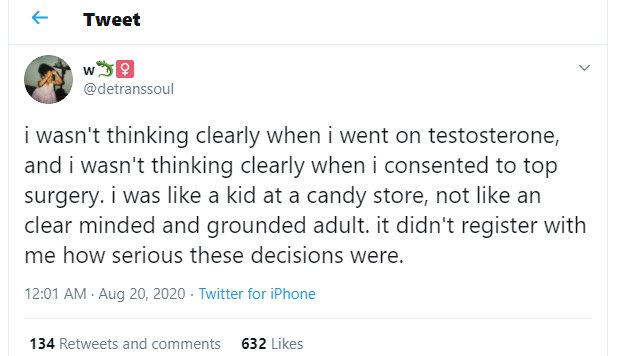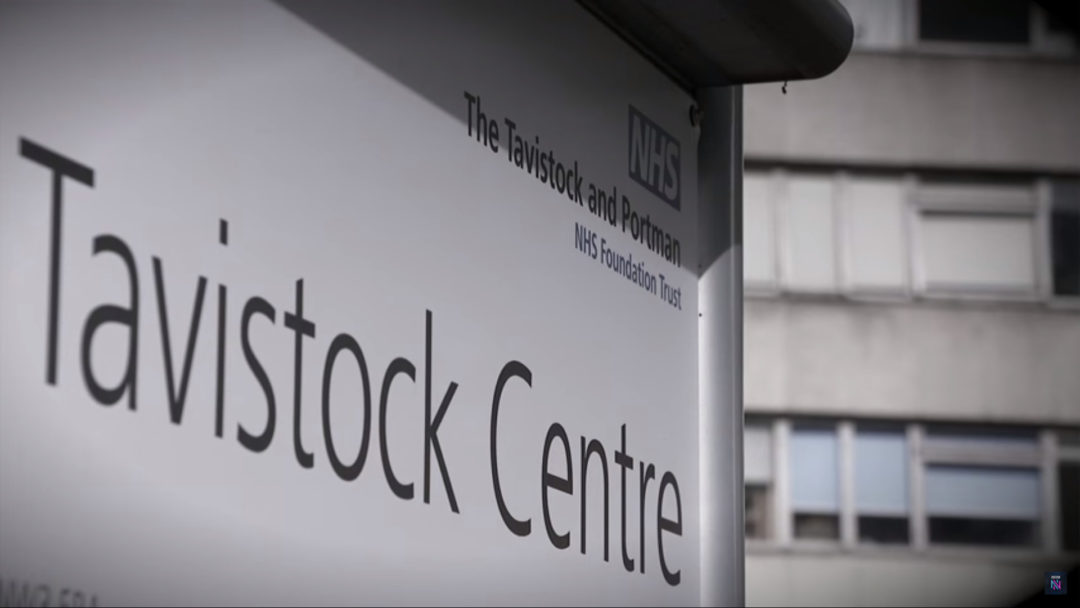Keira Bell is a detransitoner – a young woman who used to be transgender but has since desisted from the medication and behaviours associated with transgenderism.
In January 2020 Keira joined the legal action being pursued by Susan Evans, a former employee of the Gender Identity Development Service (GIDS), and a parent “A” of a teenage daughter in seeking a judicial review into the legality of the of the informed consent process at The Tavistock and Portman NHS Foundation Trust (home to the UKs main Gender Identity services).
How can a child or adolescent consent to treatment which at the very least makes permanent changes to their body and in the worst cases results in loss of organs and sterility?
There are two components to informed consent – the information given such that the consent is truly ‘informed’, and the consent itself which must be given by someone capable of making the decision.
The Consent
Many who have been through the process say they should not have been allowed to consent. They confess to being too young to comprehend the enormity of that to which they were subscribing.
Doctors are uneasy about the notion of young people consenting to such medical intervention. This poll of doctors in the Doctors.Net forum in January 2020 shows that only 13 out of 460 respondents felt the ‘application of the informed consent process’ was valid.

For a young person to be offered opposite sex imitation treatment for gender identity problems, they have to referred to a specialist clinic, in the UK that is either the Gender Identity Development Service (GIDS) for those under 18 or the Gender Identity Clinic (GIC) for those over 18. Once they have been referred to a gender clinic it is very likely that they will be put on a medical pathway which has been called the Gender Affirming Model of Treatment (GAMT). The GAMT acknowledges that the patient is the gender they claim to be and puts them on course to medical sex imitation treatment.
Adolescence is a notoriously tumultuous time in anybody’s development. It is the time in one’s life when one is desperately seeking to find an identity, to fit in somewhere. Children who, for one reason or another, have found it difficult to fit in, “quirky kids”, are especially vulnerable to joining movements which make them feel part of something.
Consider also, that these young people often have other conditions like anxiety or depression; they might also be on the autistic spectrum or have neurological differences like dyslexia. Often, these young people will be homosexual, they might also have experienced trauma or abuse.
The people promoting transgenderism know this, they prey on the vulnerable, quirky kid. We shall look at why they might be doing this in a separate article on Ideological Capture.
Young people are groomed online, or pressurised by members of their peer groups to ‘identify as transgender’; alternatively, they might choose transgenderism for themselves (once they have been introduced to the concept) as a route out of their traumatic adolescence or internalised homophobia – not realising that their feelings are not that unique, almost everybody has a rough time of it.
Susan Evans says: “Currently if a child consents to this medical treatment pathway, it will affect their adult future – a life they are not yet living and is usually envisaged, through their often distressed and dysphoric state of mind.”

It is clear to concerned parents of these children that they cannot possibly give informed consent to such life limiting medicalisation.
Young people are being ‘transitioned’ by the NHS and other health services in a large scale, uncontrolled and unethical medical experiment.
How do the medical professionals justify this reckless behaviour?
Heather Brunskell-Evans writes about how the GIDS framework for consent is meant to apply for under-16s here https://blogs.bmj.com/medical-ethics/2020/01/16/transgender-children-limits-on-consent-to-permanent-interventions/
For children over 16, GIDS assumes them to be fully ‘Gillick competent’ and so capable of giving informed consent.
But is using Gillick competence the right approach to take?
In his contribution to the House of Lords ruling, Lord Scarman said:
“As a matter of Law the parental right to determine whether or not their minor child below the age of sixteen will have medical treatment terminates if and when the child achieves sufficient understanding and intelligence to understand fully what is proposed.”
Numerous testimonies from detransitioners acknowledge that they did not ‘undersatnd fully what is proposed’.
There is a general principle stemming from the Gillick ruling that the rights of parents to exercise their duty of care to safeguard their children from harm diminishes as their child gains the intellectual maturity to make their own decisions.
Intellectual maturity is often assumed to be at 16 (for medical treatment) or 18 (for elective body modifications, like tattoos).
There are good reasons to question this simplistic, blanket approach. Competence to make decisions like these ‘does not depend on the age of the child, but on subjective features of the child in relation to the particular treatment proposal’.
We know that the issues which surround gender identity: adolescent turmoil, mental and neurological influences, and the likelihood of external societal pressures, are those which develop in line with the pre-frontal cortex. Maturity of this part of the brain does not happen until approximately 25 years old.
Is a person under 25 truly capable of consenting even when provided with all the necessary information?
There is some recognition of this in the broader NHS Long Term Plan which includes a redefinition of the upper age of adolescent services to 25 years. However, there has been little, if any, implementation of this planned change.
The Information Given
The second issue is identifying what information constitutes sufficient for the consent to be truly informed. This is a new and developing realm of medicine and the post-pubertal cohort is the newest group of affected people. There is no evidence of any positive outcomes that could arise from GAMT for this cohort because there has been no longitudinal study, and arguably no time in which to complete one, because the phenomenon developed so rapidly. There is an emerging body of evidence that the interventions used in GAMT are harmful and that desistance, detransition and/or regret are not uncommon.
The Supreme Court(Supreme Court, 2015) established a duty of care on doctors to warn patients of material risks. We know that gender identity patients are not warned of material risks. Detransitioners report they were not told of the risks, and we know that some risks are unknown – or at least not yet presented in peer reviewed journals – because this is a medical experiment. There is good reason to consider it unlikely that patients were informed that they were subject to experimentation, or even that they were participating in a clinical trial. The NHS only recently updated its guidance regarding the prescription of puberty blockers and cross sex hormones. Given that NHS England has only just admitted to further risks (which were known about, but hitherto downplayed), it is incumbent on gender services to seek new informed consent from its patients for any ongoing treatment (as hormone treatment tends to be).
Gender Affirming Medical Treatment is given to young people who:
- Are unlikely to have the rational, clarity of mind needed to consent to treatment for feelings so tightly bound to their developmental stage.
- Are not informed of reality – a girl cannot become a man; a boy cannot become a woman.
- Are not informed of the risks and likely outcomes (there are no decent longitudinal studies for the 14-25 cohort and clinicians working in gender medicine tend to be biased due to Ideological capture).
Further Reading
When can a child consent to medical transition?
Reconsidering Informed Consent for Trans-Identified Children, Adolescents, and Young Adults
https://www.tandfonline.com/doi/full/10.1080/0092623X.2022.2046221 (Published 17th March 2022)
Accessible response to the above article by the Society for Evidence-based Gender Medicine (SEGM):
https://segm.org/informed-consent-affirmative-care
References
Supreme Court, T. (2015). Montgomery (Appellant) v Lanarkshire Health Board (Respondent).

